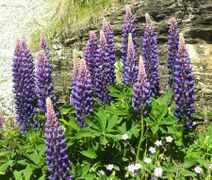Lupinus polyphyllus
| Lupinus polyphyllus | |
 | |
| Light: | |
| Moisture: | |
| Hardiness: | 3 |
| Soil pH: | 5.6-7.3 |
| Height: | 5' |
| Blooms: | Mid Summer-Late Summer |
| Native to: | |
| Nitrogen Fixer | |
| Edible Rating: | |
| Medicinal Rating: | |
| Tea: | Yes |
Lupinus polyphyllus (common name: big-leaf lupin). Stately spikes of blue and purple prove popular with bumblebees and hummingbirds and thrive in poor, but moist, soils. Garden varieties can also be red, pink, white, or multicolored, but require division as seeds never sow true and dominate bluish-purple genes become evident over time. Garden varieties are often highly poisonous with bitter alkaloids but sweet cultivars are popular livestock fodder while also enhancing soil with its nitrogen fixing abilities. Seeds remain viable for more than 50 years and plants are resilient when established, dried seeds need 12 hours of stepping in water just brought to a boil for increased germination rates. Brought to England from North America by famed botanist David Douglass, this perennial is a staple in English gardens, but care is required to prevent invasiveness in non-native locations.
Stately spikes of blue and purple prove popular with bumblebees and hummingbirds and thrive in poor, but moist, soils. Garden varieties can also be red, pink, white, or multicolored, but require division as seeds never sow true and dominate bluish-purple genes become evident over time. Garden varieties are often highly poisonous with bitter alkaloids but sweet cultivars are popular livestock fodder while also enhancing soil with its nitrogen fixing abilities. Seeds remain viable for more than 50 years and plants are resilient when established, dried seeds need 12 hours of stepping in water just brought to a boil for increased germination rates. Brought to England from North America by famed botanist David Douglass, this perennial is a staple in English gardens, but care is required to prevent invasiveness in non-native locations.
Propagation: Pre-soak the seed for 24 hours in warm water and then sow in early spring in a greenhouse[1][2]. Germination should take place within a couple of weeks. When they are large enough to handle, prick the seedlings out into individual pots and plant them out in the summer.
It should also be possible to sow the seed in situ in mid spring. It might be necessary to protect the sowing from mice.
Division in March. Difficult.
Basal cuttings, April in a cold frame. Harvest the shoots when they are about 10cm long with plenty of underground stem. Pot them up into individual pots and keep them in light shade in a cold frame or greenhouse until they are rooting well. Plant them out in the summer.
Cultivation: An easily grown plant, succeeding in any moderately good soil in a sunny position[1][2]. It strongly dislikes excessive winter wet[1]. Requires an acid to neutral soil[2]. Succeeds in poor soils[3].
Plants can be naturalized in the wild garden, especially on stream banks and for flowering above rough grass, where they may be short-lived but will self-seed[2].
Plants dislike root disturbance.
There are some named varieties, selected for their ornamental value[2].
This species has a symbiotic relationship with certain soil bacteria, these bacteria form nodules on the roots and fix atmospheric nitrogen. Some of this nitrogen is utilized by the growing plant but some can also be used by other plants growing nearby[2].
Range: Western N. America - British Columbia to California. A garden escape in Britain[4].
Habitat: Usually found in wetlands from sea level to 3000 metres[5].
Edibility: Root - raw or cooked[6].1
Medicinal: A decoction of the plant has been used as a tonic[6].
Pollinators: Bees
Soil: Can grow in light, medium, and heavy soils.
Drainage: Prefers well drained soil.
Wind: Tolerates strong winds
Seed Ripens: Mid Summer-Mid Fall
Flower Type: Hermaphrodite
Known Hazards: The seed of many lupin species contain bitter-tasting toxic alkaloids, though there are often sweet varieties within that species that are completely wholesome[7][8]. Taste is a very clear indicator. These toxic alkaloids can be leeched out of the seed
Links
- Lupinus polyphyllus - Plants for a Future
- Lupinus polyphyllus - USDA Plant Profile
References
- ↑ 1.0 1.1 1.2 Chittendon, Fred. RHS Dictionary of Plants. Oxford University Press, 1951.
- ↑ 2.0 2.1 2.2 2.3 2.4 2.5 Huxley, Anthony. The New Royal Horticultural Society Dictionary of Gardening. MacMillan Press, 1992.
- ↑ Hitchcock, Leo. Vascular Plants of the Pacific Northwest. University of Washington Press, 1955.
- ↑ Clapham, Arthur and Tom Tootin, Edmund Warburg. Flora of the British Isles. Cambridge University Press, 1962.
- ↑ Flora of California.
- ↑ 6.0 6.1 Moerman, Daniel. Native American Ethnobotany. Timber Press, 1998.
- ↑ Frohne, Dietrich and Hans Pfänder. J. A Colour Atlas of Poisonous Plants. Timber Press, 1984.
- ↑ Cooper, Marion. Poisonous Plants in Britain and their Effects on Animals and Man. The Stationery Office, 1984.